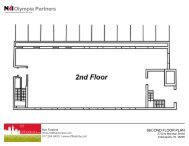2012 Global Market report - NAI Global
2012 Global Market report - NAI Global
2012 Global Market report - NAI Global
You also want an ePaper? Increase the reach of your titles
YUMPU automatically turns print PDFs into web optimized ePapers that Google loves.
declined at a faster rate. As a result, the LREI continued to increase through Q2 2009,<br />
but then finally reversed as GDP strengthened. We expect the LREI to continue to decline,<br />
as the rebound in GDP growth outpaces commercial mortgage lending. Historically,<br />
opportunistic investment periods have occurred while the LREI is declining. That is, when<br />
deleveraging occurs in the industry, as in the early 1990s, well-capitalized investors can<br />
benefit significantly. This is occurring now and will continue for another two to three years,<br />
as the economy grows more quickly than commercial mortgage debt.<br />
Industrial<br />
According to NCREIF, the US industrial vacancy rate (primarily representing institutionalquality<br />
properties) declined from 12.4% in Q1 2011 to 12.3% in Q2 2011. Industrial<br />
construction peaked in early 2009 at a seasonally-adjusted annual rate of $81.6 billion,<br />
but precipitously declined by 57% through January 2011. Activity reversed course, gaining<br />
back 23% from the bottom and standing at about $43 billion as of September 2011.<br />
Multifamily<br />
The Census Bureau’s quarterly Housing Vacancy Survey indicates that the US multifamily<br />
vacancy rate increased by 60 bps in Q3 2011 to 9.8%. This series has generally been<br />
hovering around 10% since late 2003. For NCREIF’s more institutional properties,<br />
vacancy rate decreased by 50 bps, from 5.5% in Q2 to 5.0% in Q3 2011. This<br />
discrepancy in vacancy rates is due to the fact that the NCREIF properties are generally<br />
of higher quality than the Census properties. Thus, better-quality properties are exhibiting<br />
better fundamentals. The Census vacancy rate has been relatively flat during the<br />
recession, but it increased 100 bps in Q2 and Q3 2009. In contrast, the NCREIF series<br />
exhibited a sharp increase from early 2006, as unsold high-end condos were converted<br />
to rental units. The decline starting in early 2009 indicated that the condo market<br />
overhang began to subside.<br />
Multifamily starts (5+ units) hit a low of 53,000 (annualized) in December 2010, but have<br />
since increased to 183,000 as of October 2011. Despite improving conditions, this level<br />
is in sharp contrast to the 20 and 40-year averages of 395,000 and 429,000 units,<br />
respectively. This reflects the confluence of weak recessionary demand (due to doubling<br />
up of households), an absence of construction financing, and a 9.8% Q3 2011 vacancy<br />
rate based on Census data. We anticipate that multifamily starts will remain weak through<br />
2011 and increase in <strong>2012</strong>, as lower vacancy rates, increased effective rents, and low<br />
cap rates spur development. The lack of construction has resulted in improved vacancy<br />
rates, as it means that excess inventory is being absorbed.<br />
To a large degree, the sector’s vacancy rates still reflect the fact that as the economy<br />
weakened, household formation rates plunged, as young people doubled up with family<br />
or friends. In 2008-2011, household formations averaged 650,000 per annum, versus a<br />
norm of 1.1 to 1.2 million. The result is a pent-up housing demand of roughly 1.9 million<br />
households, of which 50% will flow into multifamily housing. In <strong>2012</strong>, we expect about<br />
1.3 million households to form, consisting of both pent-up demand and normal<br />
population growth.<br />
As consumer confidence rebounds and job formation resumes, these people will form<br />
households, leading to a surge in housing demand. As a result, we are bullish on the<br />
long-term investment prospects for multifamily housing. In addition, given the sector’s<br />
<strong>2012</strong> <strong>Global</strong> <strong>Market</strong> Report n www.naiglobal.com<br />
9













